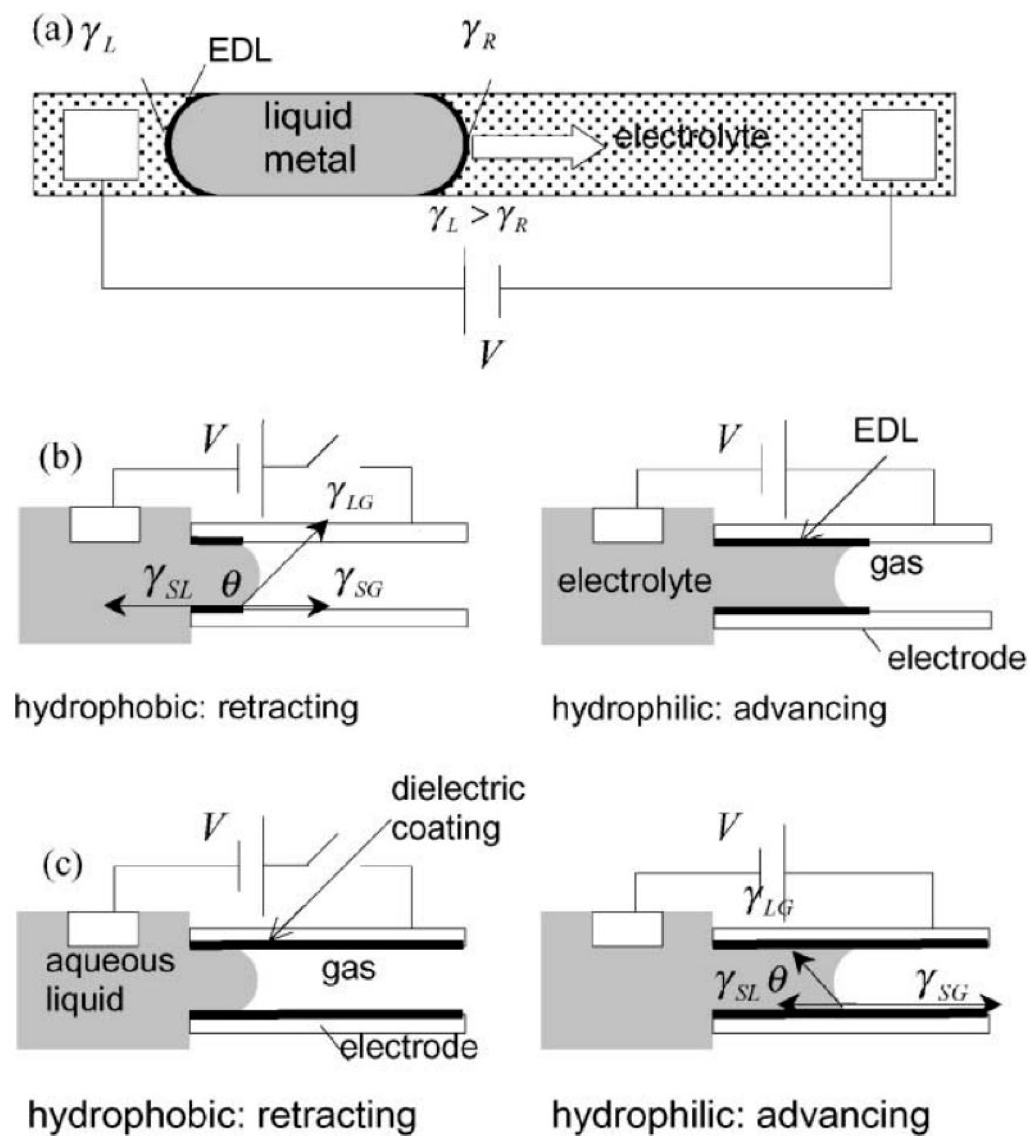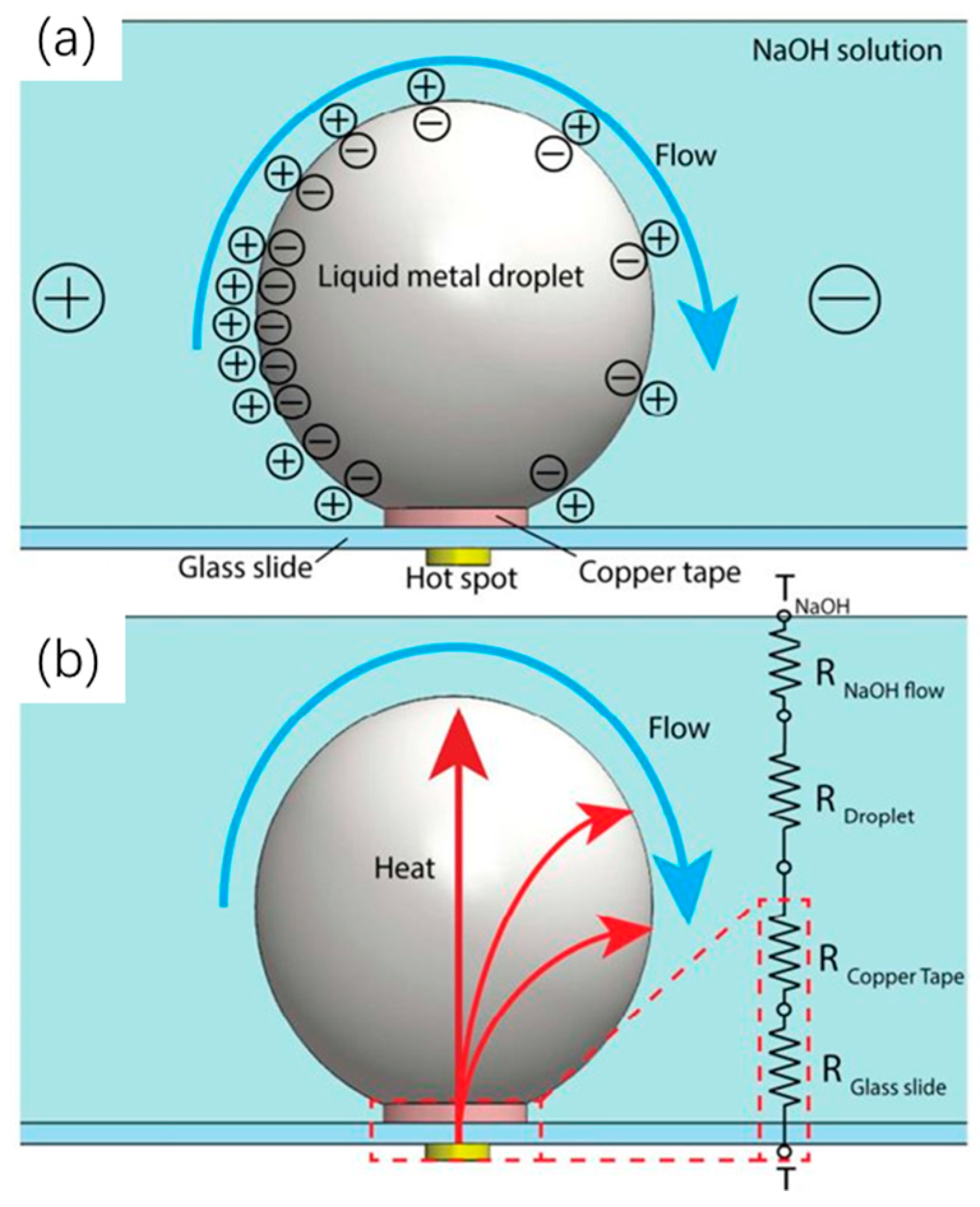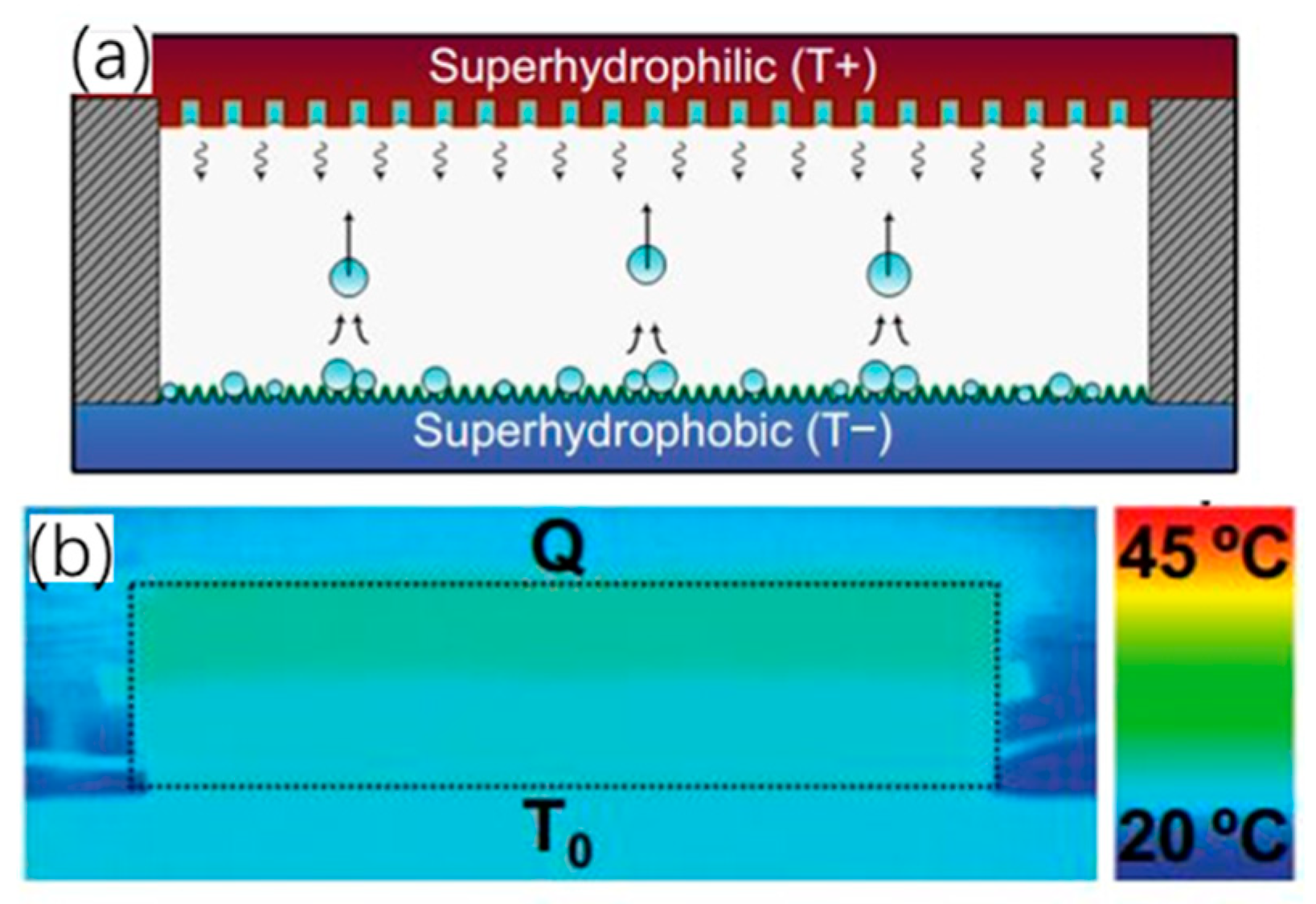Droplet-Based Microfluidic Thermal Management Methods for High Performance Electronic Devices
Abstract
:1. Introduction
2. Electrocapillarity
3. Active Droplet-Based Microfluidic Methods: Electrocapillary-Based
3.1. Continuous Eletrowetting (CEW)
3.2. Electrowetting (EW) and Electrowetting on Dielectric (EWOD)
4. Passive Droplet-Based Microfluidic Methods
5. Conclusions and Outlook
Author Contributions
Acknowledgments
Conflicts of Interest
References
- Moore, G.E. Cramming more components onto integrated circuits. Electronics 1965, 38, 114–117. [Google Scholar] [CrossRef]
- Moore, G.E. Progress In Digital Integrated Electronics. Int. Electron Device Meet. Tech. Dig. 1975, 21, 11–13. [Google Scholar]
- Waldrop, M.M. More than moore. Nature 2016, 530, 144–148. [Google Scholar] [CrossRef] [PubMed]
- Garimella, S.V.; Persoons, T.; Weibel, J.A.; Gektin, V. Electronics Thermal Management in Information and Communications Technologies: Challenges and Future Directions. IEEE Trans. Compon. Packag. Manuf. Technol. 2017, 7, 1191–1205. [Google Scholar] [CrossRef]
- Liang, G.; Mudawar, I. Review of spray cooling—Part 1: Single-phase and nucleate boiling regimes, and critical heat flux. Int. J. Heat Mass Transf. 2017, 115, 1174–1205. [Google Scholar] [CrossRef]
- Yan, Z.; Zhao, R.; Duan, F.; Wong, T.N.; Toh, K.C.; Choo, K.F.; Chan, P.K.; Chua, Y.S. Spray Cooling; InTech: Vienna, Austria, 2011; pp. 285–310. [Google Scholar]
- Browne, E.A.; Michna, G.J.; Jensen, M.K.; Peles, Y. Experimental investigation of single-phase microjet array heat transfer. J. Heat Transf. 2010, 132, 041013. [Google Scholar] [CrossRef]
- Betz, A.R.; Jenkins, J.R.; Kim, C.-J.; Attinger, D. Significant boiling enhancement with surfaces combining superhydrophilic and superhydrophobic patterns. In Proceedings of the 2011 IEEE 24th International Conference on Micro Electro Mechanical Systems (MEMS), Cancun, Mexico, 23–27 January 2011; pp. 1193–1196. [Google Scholar]
- Silverman, I.; Yarin, A.L.; Reznik, S.N.; Arenshtam, A.; Kijet, D.; Nagler, A. High heat-flux accelerator targets: Cooling with liquid metal jet impingement. Int. J. Heat Mass Transf. 2006, 49, 2782–2792. [Google Scholar] [CrossRef]
- Wang, S.; Yin, Y.; Hu, C.; Rezai, P. 3D Integrated Circuit Cooling with Microfluidics. Micromachines 2018, 9, 287. [Google Scholar] [CrossRef]
- Mudawar, I. Assessment of high-heat-flux thermal management schemes. IEEE Trans. Compon. Packag. Technol. 2001, 24, 122–141. [Google Scholar] [CrossRef]
- Zuo, Z.J.; North, M.T.; Wert, K.L. High heat flux heat pipe mechanism for cooling of electronics. IEEE Trans. Compon. Packag. Technol. 2001, 24, 220–225. [Google Scholar] [CrossRef]
- Hirshfeld, H.; Silverman, I.; Arenshtam, A.; Kijel, D.; Nagler, A. High heat flux cooling of accelerator targets with micro-channels. Nucl. Instrum. Methods Phys. Res. Sect. A Accel. Spectrom. Detect. Assoc. Equip. 2006, 562, 903–905. [Google Scholar] [CrossRef]
- Riffat, S.B.; Ma, X. Improving the coefficient of performance of thermoelectric cooling systems: A review. Int. J. Energy Res. 2004, 28, 753–768. [Google Scholar] [CrossRef]
- Rainey, K.N.; You, S.M.; Lee, S. Effect of pressure, subcooling, and dissolved gas on pool boiling heat transfer from microporous, square pin-finned surfaces in FC-72. Int. J. Heat Mass Transf. 2003, 46, 23–35. [Google Scholar] [CrossRef]
- Lee, J.; Mudawar, I. Critical heat flux for subcooled flow boiling in micro-channel heat sinks. Int. J. Heat Mass Transf. 2009, 52, 3341–3352. [Google Scholar] [CrossRef]
- Pais, M.R.; Chow, L.C.; Mahefkey, E.T. Surface Roughness and Its Effects on the Heat Transfer Mechanism in Spray Cooling. J. Heat Transf. 1992, 114, 211–219. [Google Scholar] [CrossRef]
- Cheng, J.T.; Chen, C.L. Adaptive Chip Cooling Using Electrowetting on Coplanar Control Electrodes. Nanoscale Microscale Thermophys. Eng. 2010, 14, 63–74. [Google Scholar] [CrossRef]
- Pamula, V.K.; Chakrabarty, K. Cooling of integrated circuits using droplet-based microfluidics. In Proceedings of the 13th ACM Great Lakes symposium on VLSI, Washington, DC, USA, 28–29 April 2003; pp. 84–87. [Google Scholar]
- Baird, E.; Mohseni, K. Digitized Heat Transfer: A New Paradigm for Thermal Management of Compact Micro Systems. IEEE Trans. Compon. Packag. Technol. 2008, 31, 143–151. [Google Scholar] [CrossRef]
- Che, Z.; Wong, T.N.; Nguyen, N.-T. Heat transfer enhancement by recirculating flow within liquid plugs in microchannels. Int. J. Heat Mass Transf. 2012, 55, 1947–1956. [Google Scholar] [CrossRef]
- Romano, M.; Guillaument, R.; Hany, C.; Batsale, J.C.; Pradere, C. Thermal analysis of droplet flow: Numerical, analytical and experimental investigations. Appl. Eng. 2015, 90, 403–412. [Google Scholar] [CrossRef]
- Tuckerman, D.B.; Pease, R.F.W. High-performance heat sinking for VLSI. IEEE Electron Device Lett. 1981, 2, 126–129. [Google Scholar] [CrossRef]
- Samiei, E.; Tabrizian, M.; Hoorfar, M. A review of digital microfluidics as portable platforms for lab-on a-chip applications. Lab A Chip 2016, 16, 2376–2396. [Google Scholar] [CrossRef] [PubMed]
- Ebadian, M.A.; Lin, C.X. A Review of High-Heat-Flux Heat Removal Technologies. J. Heat Transf. 2011, 133. [Google Scholar] [CrossRef]
- Lippmann, G. Relations entre les phenom enes electriques et capillaires. Ann. De Chim. Et De Phys. 1875, 5, 494–549. [Google Scholar]
- Lee, J.; Moon, H.; Fowler, J.; Schoellhammer, T.; Kim, C.-J. Electrowetting and electrowetting-on-dielectric for microscale liquid handling. Sens. Actuators A Phys. 2002, 95, 259–268. [Google Scholar] [CrossRef]
- Nelson, W.C.; Kim, C.-J.C. Droplet Actuation by Electrowetting-on-Dielectric (EWOD): A Review. J. Adhes. Sci. Technol. 2012, 26, 1747–1771. [Google Scholar] [CrossRef]
- Junghoon, L.; Chang-Jin, K. Surface-tension-driven microactuation based on continuous electrowetting. J. Microelectromech. Syst. 2000, 9, 171–180. [Google Scholar] [CrossRef]
- Mohseni, K. Effective cooling of integrated circuits using liquid alloy electrowetting. In Proceedings of the Semiconductor Thermal Measurement and Management IEEE Twenty First Annual IEEE Symposium, San Jose, CA, USA, 15–17 March 2005; pp. 20–25. [Google Scholar]
- Mohseni, K.; Baird, E.; Zhao, H. Digitized Heat Transfer for Thermal Management of Compact Microsystems. In Proceedings of the ASME International Mechanical Engineering Congress and Exposition, Orlando, FL, USA, 13–19 November 2005; pp. 617–625. [Google Scholar]
- Zhu, J.Y.; Tang, S.-Y.; Khoshmanesh, K.; Ghorbani, K. An Integrated Liquid Cooling System Based on Galinstan Liquid Metal Droplets. ACS Appl. Mater. Interfaces 2016, 8, 2173–2180. [Google Scholar] [CrossRef]
- Ma, K.; Liu, J. Liquid metal cooling in thermal management of computer chips. Front. Energy Power Eng. China 2007, 1, 384–402. [Google Scholar] [CrossRef]
- Frieder, M.; Jean-Christophe, B. Electrowetting: From basics to applications. J. Phys. Condens. Matter 2005, 17, R705. [Google Scholar]
- Beni, G.; Hackwood, S. Electro-wetting displays. Appl. Phys. Lett. 1981, 38, 207–209. [Google Scholar] [CrossRef]
- Chen, L.; Bonaccurso, E. Electrowetting—From statics to dynamics. Adv. Colloid Interface Sci. 2014, 210, 2–12. [Google Scholar] [CrossRef] [PubMed]
- Beni, G.; Tenan, M.A. Dynamics of electrowetting displays. J. Appl. Phys. 1981, 52, 6011–6015. [Google Scholar] [CrossRef]
- Berge, B. Electrocapillarite et mouillage de films isolants par l’eau. Comptes Rendus—Acad. Des. Sci. Paris Ser. 1993, 2, 157. [Google Scholar]
- Paik, P.Y.; Pamula, V.K.; Chakrabarty, K. A Digital-Microfluidic Approach to Chip Cooling. IEEE Des. Test Comput. 2008, 25, 372–381. [Google Scholar] [CrossRef]
- Paik, P.; Pamula, V.K.; Chakrabarty, K. Adaptive Hot-Spot Cooling of Integrated Circuits Using Digital Microfluidics. In Proceedings of the ASME 2005 International Mechanical Engineering Congress and Exposition Microelectromechanical Systems, Orlando, FL, USA, 5–11 November 2005; pp. 673–678. [Google Scholar]
- Paik, P.Y.; Pamula, V.K.; Chakrabarty, K. Adaptive Cooling of Integrated Circuits Using Digital Microfluidics. IEEE Trans. Large Scale Integr. (VLSI) Syst. 2008, 16, 432–443. [Google Scholar] [CrossRef]
- Alavi, S.; Kazemi, A.; Passandideh-Fard, M. Hot-spot cooling using microliter liquid drops. Appl. Eng. 2015, 76, 310–323. [Google Scholar] [CrossRef]
- Baelmans, M.; Oprins, H.; Stevens, T.; Rogiers, F. Digital and Continuous Liquid Cooling for Electronic Systems. In Proceedings of the 2007 International Conference on Thermal, Mechanical and Multi-Physics Simulation Experiments in Microelectronics and Micro-Systems, London, UK, 16–18 April 2007; pp. 1–7. [Google Scholar]
- Oprins, H.; Veken, G.V.D.; Nicole, C.C.S.; Lasance, C.J.M.; Baelmans, M. On-Chip Liquid Cooling With Integrated Pump Technology. IEEE Trans. Compon. Packag. Technol. 2007, 30, 209–217. [Google Scholar] [CrossRef]
- Bahadur, V.; Garimella, S.V. Energy minimization-based analysis of electrowetting for microelectronics cooling applications. Microelectron. J. 2008, 39, 957–965. [Google Scholar] [CrossRef]
- Kumari, N.; Garimella, S.V. Characterization of the heat transfer accompanying electrowetting or gravity-induced droplet motion. Int. J. Heat Mass Transf. 2011, 54, 4037–4050. [Google Scholar] [CrossRef]
- Jian, G.; Gilhwan, C.; Ju, Y.S.; Chang-Jin, C.J.K. Thermal switches based on coplanar EWOD for satellite thermal control. In Proceedings of the 2008 IEEE 21st International Conference on Micro Electro Mechanical Systems, Wuhan, China, 13–17 January 2008; pp. 848–851. [Google Scholar]
- Cha, G.; Kim, C.-J.; Ju, Y.S. Thermal conductance switching based on the actuation of liquid droplets through the electrowetting on dielectric (EWOD) phenomenon. Appl. Eng. 2016, 98, 189–195. [Google Scholar] [CrossRef]
- Moon, H.; Bindiganavale, S.; Nanayakkara, Y.; Armstrong, D.W. Digital Microfluidic Device Using Ionic Liquids for Electronic Hotspot Cooling. In Proceedings of the ASME 2009 7th International Conference on Nanochannels, Microchannels, and Minichannels, Pohang, Korea, 22–24 June 2009. [Google Scholar]
- Park, S.-Y.; Nam, Y. Single-Sided Digital Microfluidic (SDMF) Devices for Effective Coolant Delivery and Enhanced Two-Phase Cooling. Micromachines 2017, 8, 3. [Google Scholar] [CrossRef]
- Park, S.-Y.; Cheng, J.; Chen, C.-L. Active Hot Spot Cooling Controlled by Single-Sided Electrowetting-on-Dielectric (SEWOD). In Proceedings of the ASME 2012 Heat Transfer Summer Conference collocated with the ASME 2012 Fluids Engineering Division Summer Meeting and the ASME 2012 10th International Conference on Nanochannels, Microchannels, and Minichannels, Rio Grande, CO, USA, 8–12 July 2012. [Google Scholar]
- Hale, R.S.; Bahadur, V. Electrowetting Heat Pipes for Heat Transport Over Extended Distances. IEEE Trans. Compon. Packag. Manuf. Technol. 2015, 5, 1441–1450. [Google Scholar] [CrossRef]
- Renee, S.H.; Vaibhav, B. Electrowetting-based microfluidic operations on rapid-manufactured devices for heat pipe applications. J. Micromech. Microeng. 2017, 27, 075004. [Google Scholar]
- Chakraborty, M.; Ghosh, A.; DasGupta, S. Enhanced microcooling by electrically induced droplet oscillation. RSC Adv. 2014, 4, 1074–1082. [Google Scholar] [CrossRef]
- Chakraborty, M.; Anand, R.; Rao, P.S.; Sen, S.; DasGupta, S. Oscillating nanofluid droplet for micro-cooling. Sens. Actuators B Chem. 2017, 239, 562–570. [Google Scholar] [CrossRef]
- Nampoothiri, K.N.; Srinivasan, V.; Bobji, M.S.; Sen, P. Active thermal cooling using liquid dielectrophoresis. In Proceedings of the 2016 3rd International Conference on Emerging Electronics (ICEE), Mumbai, India, 27–30 December 2016; pp. 1–4. [Google Scholar]
- Verheijen, H.J.J.; Prins, M.W.J. Reversible Electrowetting and Trapping of Charge: Model and Experiments. Langmuir 1999, 15, 6616–6620. [Google Scholar] [CrossRef]
- Lee, H.; Yun, S.; Ko, S.H.; Kang, K.H. An electrohydrodynamic flow in ac electrowetting. Biomicrofluidics 2009, 3, 044113. [Google Scholar] [CrossRef] [PubMed]
- García-Sánchez, P.; Ramos, A.; Mugele, F. Electrothermally driven flows in ac electrowetting. Phys. Rev. E 2010, 81, 015303. [Google Scholar] [CrossRef]
- Samiei, E.; de Leon Derby, M.D.; den Berg, A.V.; Hoorfar, M. An electrohydrodynamic technique for rapid mixing in stationary droplets on digital microfluidic platforms. Lab A Chip 2017, 17, 227–234. [Google Scholar] [CrossRef]
- Boreyko, J.B.; Zhao, Y.; Chen, C.-H. Planar jumping-drop thermal diodes. Appl. Phys. Lett. 2011, 99, 234105. [Google Scholar] [CrossRef]
- Boreyko, J.B.; Chen, C.-H. Self-Propelled Dropwise Condensate on Superhydrophobic Surfaces. Phys. Rev. Lett. 2009, 103, 184501. [Google Scholar] [CrossRef] [PubMed]
- Boreyko, J.B.; Chen, C.-H. Self-propelled jumping drops on superhydrophobic surfaces. Phys. Fluids 2010, 22, 091110. [Google Scholar] [CrossRef]
- Boreyko, J.B.; Chen, C.-H. Vapor chambers with jumping-drop liquid return from superhydrophobic condensers. Int. J. Heat Mass Transf. 2013, 61, 409–418. [Google Scholar] [CrossRef]
- Miljkovic, N.; Preston, D.J.; Enright, R.; Wang, E.N. Electrostatic charging of jumping droplets. Nat. Commun. 2013, 4, 2517. [Google Scholar] [CrossRef] [PubMed]
- Miljkovic, N.; Enright, R.; Nam, Y.; Lopez, K.; Dou, N.; Sack, J.; Wang, E.N. Jumping-Droplet-Enhanced Condensation on Scalable Superhydrophobic Nanostructured Surfaces. Nano Lett. 2013, 13, 179–187. [Google Scholar] [CrossRef] [PubMed]
- Miljkovic, N.; Preston, D.J.; Enright, R.; Wang, E.N. Electric-Field-Enhanced Condensation on Superhydrophobic Nanostructured Surfaces. ACS Nano 2013, 7, 11043–11054. [Google Scholar] [CrossRef] [PubMed]
- Oh, J.; Birbarah, P.; Foulkes, T.; Yin, S.L.; Rentauskas, M.; Neely, J.; Pilawa-Podgurski, R.C.N.; Miljkovic, N. Jumping-droplet electronics hot-spot cooling. Appl. Phys. Lett. 2017, 110, 123107. [Google Scholar] [CrossRef]







| Category | Cooling Method | Coolant | Removal Heat Flux (W/cm2) | Ref. |
|---|---|---|---|---|
| Passive | Free convection | Air | 15 | [11] |
| Active | Forced convection (Heat sink with a fan) | Air | 35 | [11] |
| Passive | Heat pipe | Water | 250 | [12] |
| Active | Microchannel | Water | 1430 | [13] |
| Active | Peltier cooler | Electron | 125 | [14] |
| Passive | Pool boiling | FC-72 | 140 | [15] |
| Active | Flow boiling | HFE 7100 | 700 | [16] |
| Active | Spray cooling | Water | 1200 | [17] |
| Active | Jet impingement | GaIn | 2000 | [9] |
| Active | Electrocapillarity | Water | 27 | [18] |
| Liquid Metal or Alloy | Density kg/m3 | Melting Point °C | Boiling Point °C | Evaporation Pressure/mmHg | Thermal Cond. W/m·K | Specific Heat J/(kg∙°C) | Viscosity kg/(m·s) | Surface Tension N/m | Ref. |
|---|---|---|---|---|---|---|---|---|---|
| Hg | 13546 | −39 | 356.65 | 1.68 × 10−3 (a) | 8.4 | 140 | 0.15 × 10−3 | 0.47 | [33] |
| Ga | 6093 | 29.98 | 1983 | 10−12 | 33.49 | 343.32 | 1.89 × 10−3 | 0.735 | |
| Cesium | 1796 (d) | 28.65 | 2023.84 | 10−6 (d) | 17.4 (d) | 236 (d) | — | 0.248 (d) | |
| Rubidium | 1470 (m) | 38.85 | 685.73 | 6 × 10−6 | 29.3 (m) | 363 (m) | — | 0.081 | |
| Potassium | 664 (m) | 63.2 | 756.5 | 6 × 10−7 | 54.0 m) | 780 (m) | — | 0.103 (d) | |
| Sodium | 926.9 (d) | 97.83 | 881.4 | 10−10 | 86.9 (c) | 1380 (d) | — | 0.194 (d) | |
| Indium | 7030 (c) | 156.8 | 2023.8 | <10−10 | 36.4 (c) | 270 (m) | — | 0.55 (m) | |
| Lithium | 515 (b) | 186 | 1342.3 | 10−10 | 41.3 (b) | 4389 (b) | — | 0.405 (b) | |
| Tin | 6940 (c) | 232 | 2622.8 | <10−10 | 15.08 (b) | 257 | — | 0.531 (m) | |
| Water | 1000 | 0 | 100 | — | 0.6 | 4184 | 0.86 × 10−3 | 0.0717 | |
| NaK | 860 | −12.6 | 785 | — | 0.232 at °C | 949 | 0.522 × 10−3 | 0.12 | [31] |
| Bi-alloys | ~9500 | 47–271 | 8.4 | — | 15 | 197 | — | — | |
| Indalloy 46L | 6499 | 7.6 | — | — | — | — | — | — | |
| Indalloy 51 | 6499 | 10.7 | — | — | — | — | — | — | |
| Indalloy 60 | 6350 | 15.7 | — | — | — | — | — | — | |
| Indalloy 77 | 6145 | 25 | — | — | — | — | — | — |
© 2019 by the authors. Licensee MDPI, Basel, Switzerland. This article is an open access article distributed under the terms and conditions of the Creative Commons Attribution (CC BY) license (http://creativecommons.org/licenses/by/4.0/).
Share and Cite
Yan, Z.; Jin, M.; Li, Z.; Zhou, G.; Shui, L. Droplet-Based Microfluidic Thermal Management Methods for High Performance Electronic Devices. Micromachines 2019, 10, 89. https://doi.org/10.3390/mi10020089
Yan Z, Jin M, Li Z, Zhou G, Shui L. Droplet-Based Microfluidic Thermal Management Methods for High Performance Electronic Devices. Micromachines. 2019; 10(2):89. https://doi.org/10.3390/mi10020089
Chicago/Turabian StyleYan, Zhibin, Mingliang Jin, Zhengguang Li, Guofu Zhou, and Lingling Shui. 2019. "Droplet-Based Microfluidic Thermal Management Methods for High Performance Electronic Devices" Micromachines 10, no. 2: 89. https://doi.org/10.3390/mi10020089





